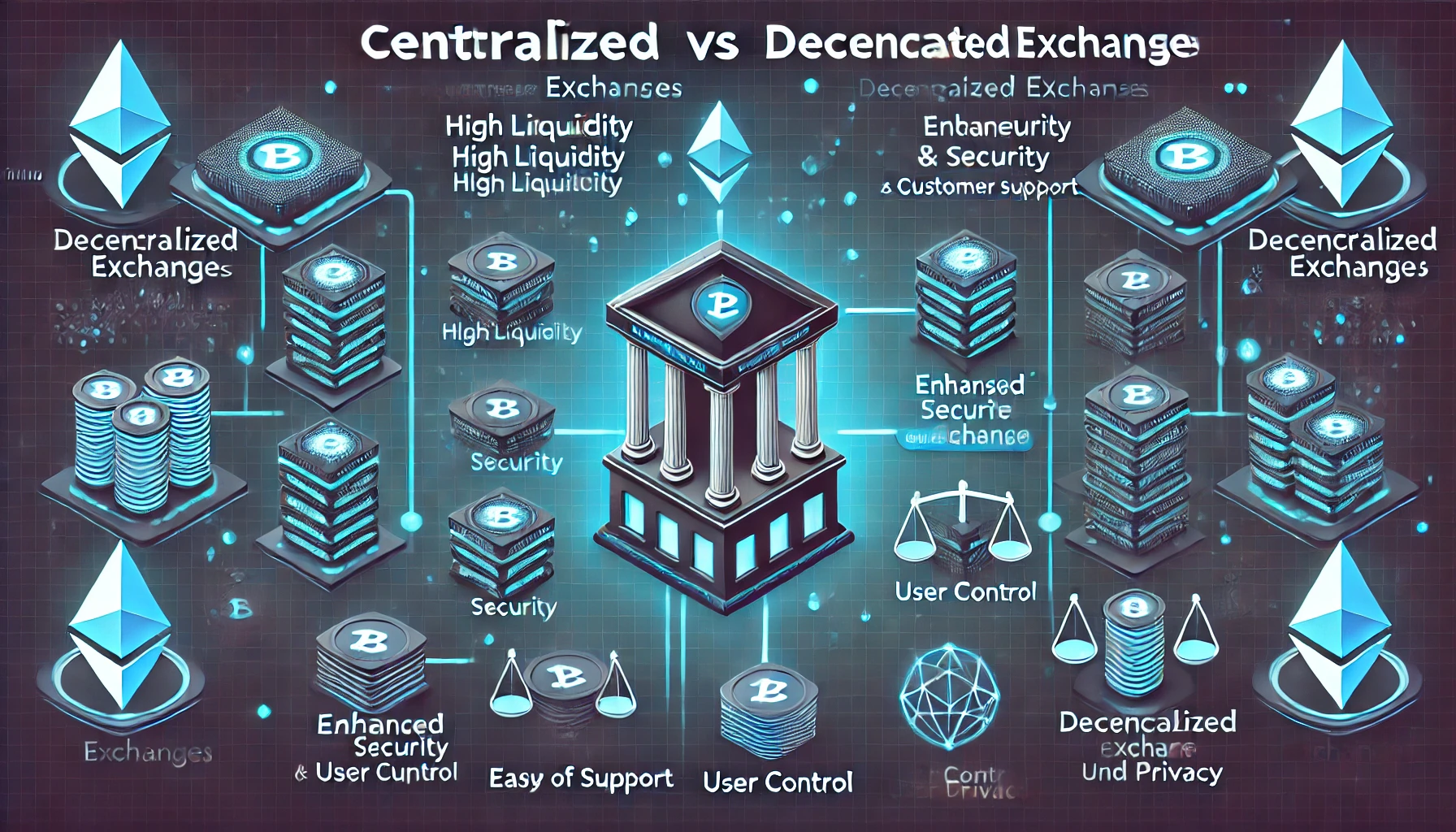What is Centralized and Decentralized Exchange?
Centralized and decentralized exchange are fundamental to the world of cryptocurrency trading. Understanding the distinctions between them can significantly impact your trading strategy and overall experience. Centralized exchanges (CEX) and decentralized exchanges (DEX) offer different advantages and disadvantages, making them suitable for various trading needs and preferences.
Background of Centralized and Decentralized Exchange
Cryptocurrency exchanges serve as platforms where users can buy, sell, and trade cryptocurrencies. The main difference between centralized and decentralized exchanges lies in how they operate and manage transactions. Centralized exchanges are managed by a single entity that oversees all transactions, providing a controlled environment. In contrast, decentralized exchanges operate without a central authority, enabling direct peer-to-peer transactions.
Origin/History
The concept of centralized exchanges dates back to traditional financial markets where a central authority or organization oversees trading activities. Consequently, centralized cryptocurrency exchanges such as Coinbase and Binance emerged as early leaders, offering user-friendly interfaces and high liquidity.
In contrast, decentralized exchanges were developed to align with the core principles of blockchain technology, emphasizing transparency, security, and user control. Uniswap and Sushiswap are popular DEXs that have gained traction for their innovative approach to trading.
| Exchange Type | Origin |
|---|---|
| Centralized Exchange (CEX) | Traditional financial markets |
| Decentralized Exchange (DEX) | Blockchain technology principles |
Types of Exchange
Cryptocurrency exchanges can be broadly classified into two categories: centralized and decentralized.
- Centralized exchanges (CEX): operated by companies that act as intermediaries between buyers and sellers. Users must create accounts, undergo verification processes, and deposit funds into the exchange’s wallets.
- Decentralized exchanges (DEX): operate without a central authority, allowing users to trade directly from their wallets. This peer-to-peer trading model leverages smart contracts to facilitate transactions.
How CEX and DEX Work?
- Centralized Exchanges: Users deposit funds into exchange wallets, the exchange matches buy and sell orders, and the platform charges fees for transactions and withdrawals.
- Decentralized Exchanges: Users connect their wallets to the DEX platform, trades are executed via smart contracts, and transactions occur directly between users with minimal fees.
Pros and Cons
Understanding the advantages and disadvantages of each type of exchange can help you choose the best platform for your needs.
| Aspect | Centralized Exchanges (CEX) | Decentralized Exchanges (DEX) |
|---|---|---|
| Security | Higher risk due to central authority | Lower risk; user-controlled funds |
| Ease of Use | User-friendly interfaces | Requires technical knowledge |
| Liquidity | High liquidity | Variable liquidity |
| Fees | Higher fees | Lower fees |
| Privacy | Requires KYC/AML | No personal information required |
Companies
Several companies operate prominent centralized and decentralized exchanges. Here are some notable examples:
Centralized Exchange Companies
- Coinbase: One of the most popular and user-friendly centralized exchanges, known for its strong security measures and regulatory compliance.
- Binance: Offers a wide range of cryptocurrencies and trading pairs, with high liquidity and advanced trading features.
Decentralized Exchange Companies
- Uniswap: A leading DEX built on the Ethereum blockchain, known for its automated market-making protocol.
- Sushiswap: Another popular DEX, which originated as a fork of Uniswap but has since developed its unique features and governance model.
CEX vs DEX
When comparing Centralized vs Decentralized Exchange, several factors come into play, including security, fees, liquidity, and user experience. CEX platforms like Coinbase and Binance offer higher liquidity and user-friendly interfaces but involve higher fees and centralized control, which can be a security risk. On the other hand, DEX platforms like Uniswap and Sushiswap provide enhanced security and privacy, as they operate on a decentralized model, allowing users to control their funds. However, DEXs may require more technical knowledge to navigate and can have lower liquidity compared to their centralized counterparts.
Secure CEX and DEX
Centralized exchanges (CEX) are platforms where users deposit their funds into exchange-managed wallets. Key security features of secure CEX platforms include:
- Two-Factor Authentication (2FA): Platforms like Coinbase and Binance enhance security with 2FA, requiring a second verification step via mobile app or SMS.
- Cold Storage: Most user funds are stored offline in cold storage to protect against online threats, with only a small portion in internet-connected hot wallets for daily transactions.
- Insurance Policies: Exchanges like Coinbase offer insurance to cover losses from hacks or breaches.
- Regulatory Compliance: Exchanges such as Kraken and Gemini comply with stringent regulatory standards and undergo regular audits, boosting trust and security.
Decentralized exchanges (DEX) operate on a peer-to-peer model, allowing direct trading from user wallets without intermediaries. Key security features of secure DEX platforms include:
- Non-Custodial Trading: Platforms like Uniswap and Sushiswap allow users to retain control of their funds, reducing hack and theft risks.
- Smart Contracts: DEX trades are executed via smart contracts, which are audited to prevent vulnerabilities.
- Decentralized Governance: Platforms like Uniswap involve the community in decision-making processes, increasing transparency and security.
- Open Source Code: The open-source nature of many DEX platforms lets developers and security experts review and improve the code.
References
- Centralized vs decentralized crypto exchanges. CoinLedger.
- Centralized vs decentralized crypto exchanges. Experian.
- Centralized and decentralized cryptocurrency exchanges: Key differences. Wealthsimple.
- Decentralized vs centralized: Understanding the differences. Blockchain Council.
- Centralization: Definition, importance, pros & cons. Corporate Finance Institute.

